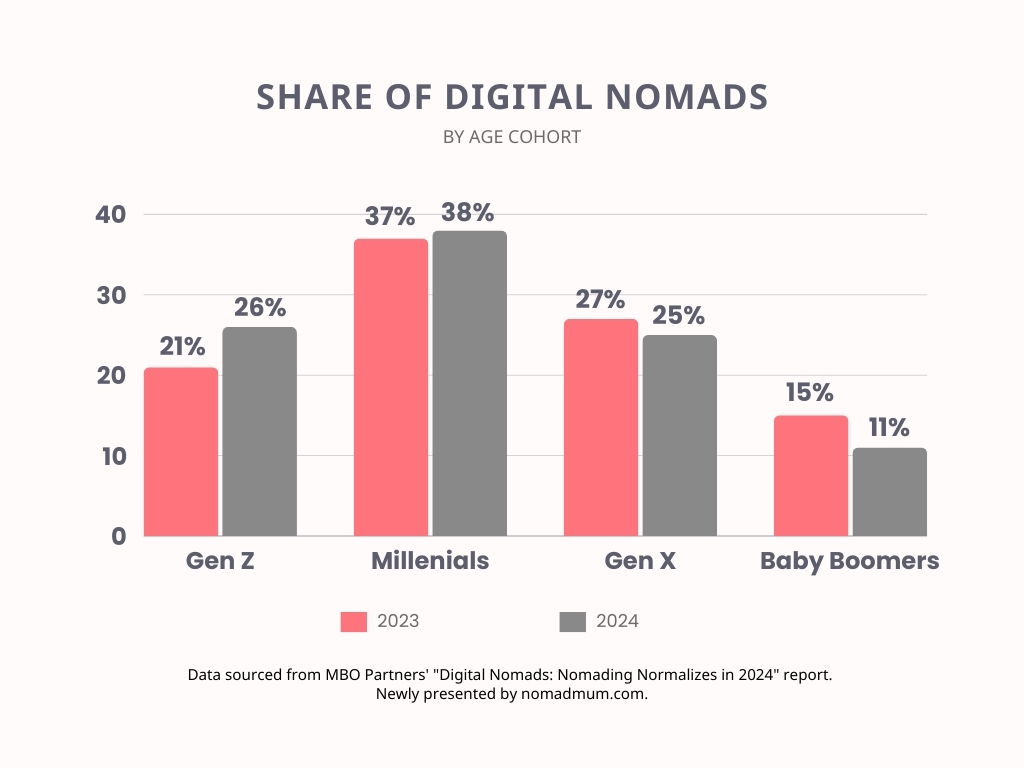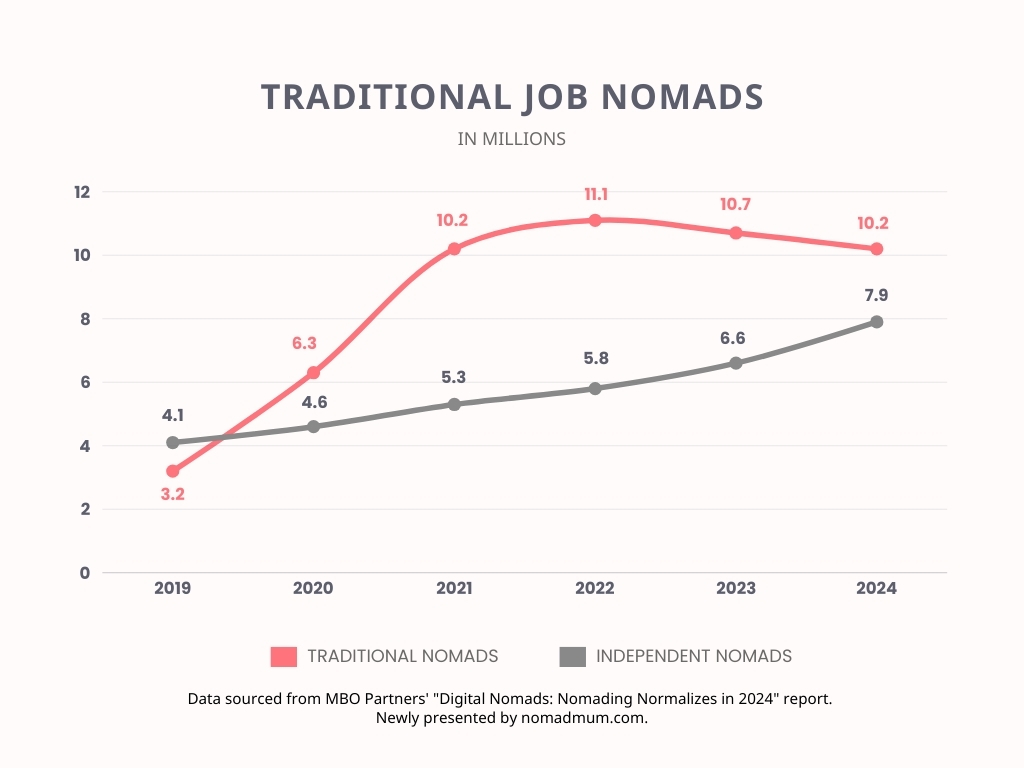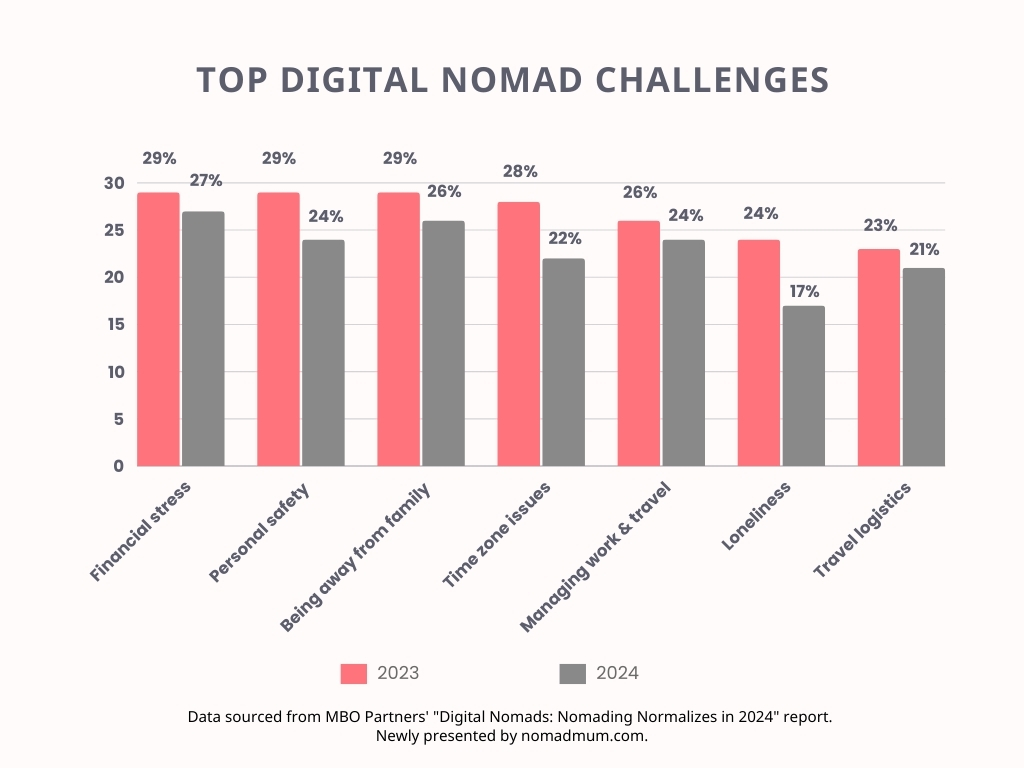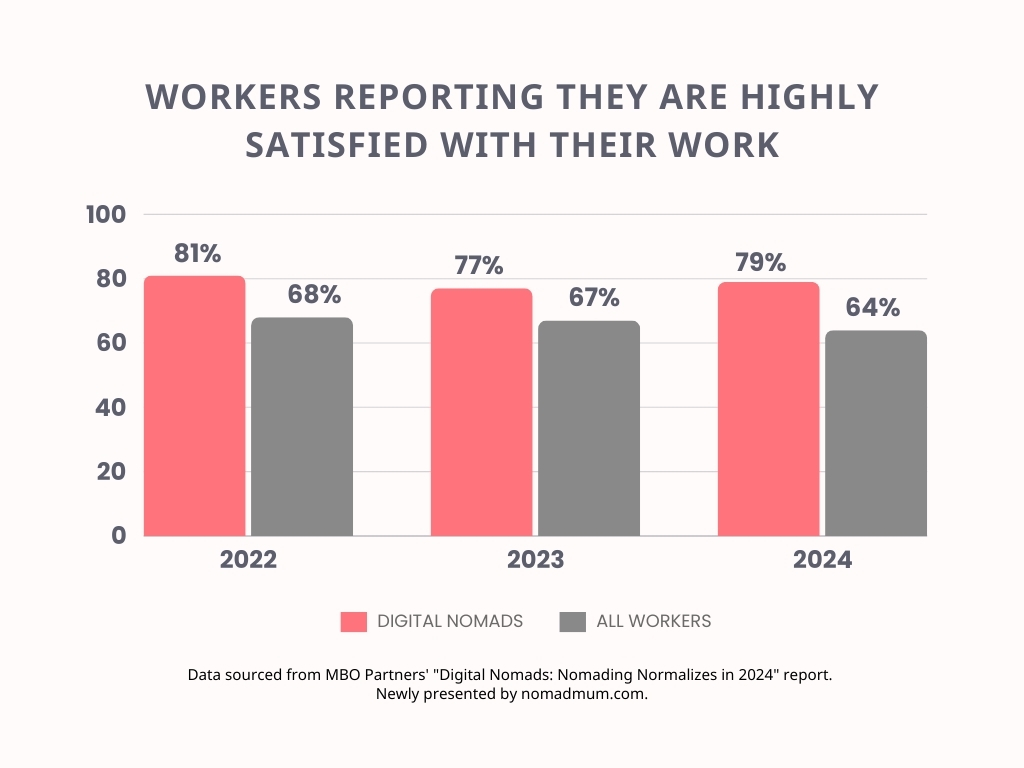Are you thinking about becoming a digital nomad, or have you already taken the first step into the nomadic lifestyle? Then you’re not alone. Digital nomading has never been as popular as it is today! The new research from MBO Partners 2024 State of Independence surveyed 6,526 U.S. residents in June 2024, including 1,055 digital nomads. This represents the current percentage of digital nomads in U.S. society.
Here’s a breakdown of the most surprising findings. Let’s go!

Digital Nomads Today: A Movement That’s Booming
In 2024, digital nomads are no longer a rare sight. With 18.1 million Americans identifying as digital nomads, that’s 11% of the U.S. workforce! The lifestyle has exploded, growing by a massive 147% since 2019. But who exactly are digital nomads? They’re people who work remotely while traveling, whether for a few weeks, months or even the entire year.
Some are “traditional” nomads, holding regular jobs but with the flexibility to work from new cities, while others are “independent” nomads, freelancing or running their own businesses.
Who’s Behind the Digital Nomad Boom?
So, who exactly are these digital nomads? Well, most of them are young! Gen Z and Millennials make up 64% of the nomad crowd. Interestingly, men are still in the majority at 59%, but there’s a growing number of African American nomads, now making up 21%—a big jump from just a few years ago.
And it’s not just solo adventurers—over half of digital nomads are married or living with a partner. And believe it or not, 23% are traveling with kids! That’s, of course, my personal favorite fact! Even though being a digital nomad family sucks (sometimes).
Independent Nomads Take the Lead in 2024
In 2024, we’re seeing a big rise in “independent nomads”—those who work for themselves and aren’t tied to any office. These independent workers have grown by 20%, as more people take control of when and where they work. Unlike traditional job nomads, who’ve had to deal with return-to-office rules and saw a decline in numbers, independent nomads have the freedom to stay on the road.
They can visit new places and explore hidden gems along the way. It’s clear that being your own boss makes it a lot easier to live the digital nomad dream!
The Top Challenges of Nomading
Being a digital nomad is exciting, but it does come with a few bumps along the way. The top challenges nomads face are financial stress (27%), being away from family and friends (26%), personal safety concerns (24%), different time zones that make work tricky (23%), and endless planning that can lead to travel burnout (21%).
But here’s the good news: these challenges have gotten a bit easier since 2020, thanks to fewer pandemic restrictions making travel smoother. And despite challenges, some find that the nomadic lifestyle is the only way to experience new places, meet new people, and embrace local language and customs.
Why Digital Nomads Are Happier at Work
Digital nomads are a happy bunch when it comes to their work! In 2024, 79% of digital nomads reported being highly satisfied, and this has stayed consistent over the last few years.
Compared to traditional workers, who report much lower satisfaction levels, nomads are clearly enjoying the perks of their lifestyle.
One big reason for this is “geo-arbitrage,” where nomads live in places with low costs of living while earning money from higher-wage countries. This allows them to stretch their income further and enjoy more freedom. Check out my honest cost breakdown as a digital nomad family in Koh Phangan, Thailand.
Is Digital Nomading a Lifelong Choice?
Most digital nomads love their lifestyle, with 95% saying they plan to continue—60% definitely and 35% maybe.
But it’s not always a long-term commitment. Only 15% of current nomads have been doing it for more than five years, and the majority (67%) have been nomads for three years or less.
The truth is, combining constant travel with work can be tough, and around 15% to 17% of nomads return to a home base or traditional lifestyle each year.
However, the nomad life still has a strong pull—21% of former nomads say they will return, and 58% think they might come back to it someday. So while not everyone sticks with it forever, the freedom of the nomadic lifestyle is hard to leave behind.
Slowing Down: The “Slowmad” Revolution
A new type of digital nomad is making waves—meet the “slowmads” (btw we’re slowmads too and love it!). These nomads prefer to travel at a slower pace, visiting fewer places but staying longer in each spot, often discovering cozy spots and must-visit places.
On average, slowmads now spend about 5.7 weeks at each location, compared to 5.4 weeks in 2023. This trend has been growing over the last few years, as more nomads realize that staying longer helps them feel more settled, make new friends, and dive deep into the culture. Plus, it reduces travel stress and makes it easier to get work done.
Nomad Families on the Rise: Kids, Pets, and All
More families are hitting the road as digital nomads, and the numbers keep growing. Woohoo! In 2024, 23% of digital nomads are traveling with their children, which shows how much this lifestyle has developed over the years.
Parents love the idea of exposing their kids to new cultures, places, and adventures, but it’s not without challenges. Education and socialization are big hurdles for nomad families, especially with 86% of their kids being school-aged. Many parents turn to homeschooling, while others choose private or public schools in the countries they visit. Have you ever heard of unschooling and deschooling? If not, you should read my interview with fellow Nomad mom Moira Mills.
Even with the challenges, many families with kids find it worth it because they learn to be resilient and adaptable. And it’s not just kids—11% of nomads travel with their pets too!

Tech-Savvy Nomads: AI is Their Secret Weapon
Digital nomads are not just travelers—most of them are tech-savvy pros! A whopping 79% of digital nomads use AI in their work, and many say they’ve got advanced skills in this area.
Over the years, digital nomads have become even more skilled and educated, with 52% holding a college degree or higher. They often work in tech-related fields like IT, creative services, and marketing.
In this article, I’m sharing my personal journey on how I became a digital nomad copywriter and how you can do the same!
The Hidden Nomads: A Risky Double Life
Some digital nomads are living double lives! Around 14% of digital nomads with traditional jobs admit that their employers don’t even know they’re traveling while working, and another 22% have informal “okay” agreements with their bosses but no official company policy.
These hidden nomads are off the radar, which can cause issues like tax, legal, and compliance risks for their companies. Despite these challenges, most businesses haven’t set up proper policies for nomadic employees.
While it sounds exciting, being a secret digital nomad can also create cybersecurity risks and a few tricky situations for both workers and employers.
Over the years, this trend of “hidden” nomads continues, with about one-third of traditional job nomads flying under the radar!
Around 14% of digital nomads with traditional jobs admit that their employers don’t even know they’re traveling while working.
Nomad Dreamers: Many Aspire, Few Take the Leap
Millions of people dream of becoming digital nomads, but only a handful of people take the leap! In 2024, about 21 million Americans said they plan to become digital nomads in the next few years, with another 45 million saying “maybe.”
However, this number is down by 7% from 2023, likely due to stricter return-to-office policies and global uncertainties. Despite the big dreams, only 7% to 9% of those hopefuls actually make the switch to nomading.
The rest become what we call “armchair digital nomads”—following others’ adventures online without packing their own bags.

Digital Nomads: Here to Stay and Growing Stronger
Just six years ago, digital nomads were seen as a quirky and fringe group, but fast forward to 2024, and they’ve gone mainstream. Over 10% of working Americans now identify as digital nomads, and the trend shows no signs of slowing down.
With more companies embracing flexible work policies, allowing employees to travel while working, digital nomadism has built a strong foundation for future growth. Big companies are realizing it’s a win-win—these workers have in-demand skills and love the freedom of working from anywhere.
Meanwhile, governments around the world are jumping on the bandwagon, offering special visas to attract digital nomads. Over 60 countries now have programs making it easier for nomads to live and work there. And it’s not just visas—there’s now a whole industry catering to nomads, with services like cross-border health insurance, temporary workspaces, and even digital nomad villages where they can live, work, and connect with other nomads.
On top of all that, the tech world is making life even more accessible for nomads. Faster internet, better collaboration tools, and improved remote work setups mean digital nomads can stay productive no matter where they are. It’s clear that digital nomadism has moved from a fringe lifestyle to a well-supported, growing movement that’s here to stay!
👉 You might also find these articles interesting:
– How to Travel Around The World and Make Money
– 20 Remote Work-From-Home Jobs With No Experience Needed
– Amazon Remote Jobs and What They Pay
– What is a Digital Nomad? Everything You Should Know
Conclusion: Digital Nomading is Set to Keep Growing
Whether you’re already a digital nomad or just dreaming about it —this lifestyle is here to stay! With more tools, support, and flexibility, it’s easier than ever to work while traveling.
And that’s something I personally see a lot here in Southeast Asia. The new normal: Restaurants and coffee shops are set up for remote workers and provide power plugs. Hotels and Airbnbs advertise high-speed Wi-Fi and offer more and more workspaces in their rooms. I also meet lots of people who are becoming more agile in their thinking. They’re educating themselves to perform remote work and fulfill their dream of full-time traveling, financial freedom and nomading.
I think this development is fantastic. What do you think? Please let me know in the comments!
Thanks so much for reading and for making me a part of your day! Yours, Lulu










